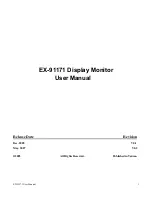
6
Chapter1Introduction
Chapter 1 Introduction
Thank you very much for choosing an EIZO monochrome LCD monitor.
1-1. Features
• 21.3 inches
• Applicable to the resolution of 2M pixels (Portrait : 1200 × 1600 dots (H × V))(GX240-CL)
• Applicable to the resolution of 3M pixels (Portrait : 1536 × 2048 dots (H × V))(GX340-CL)
• Uses high-contrast panel
Enables the display of sharp images.
- 1400 : 1
• Applicable to DisplayPort (applicable to 8 bit or 10 bit, not applicable to audio signals)
• The Hybrid Gamma function automatically identifies the display area for the medical and other images on
the same screen, and displays each set status.
*1 The identification may fail depending on the displayed image. The software to be used needs to be verified. For
validation, see
“To set the highlight area in the image display area” (page 13)
.
• The RadiCS SelfQC function and the built-in Integrated Front Sensor allow the user to perform the
calibration and Grayscale Check for the monitor independently.
See
“Chapter 4 Controlling Monitor Quality” (page 18)
*2 When a panel protector (RP-903) is installed, the Integrated Front Sensor cannot be used.
• The quality control software “RadiCS LE (for Windows)” used to calibrate the monitor and to manage the
history is included
See
“1-2. EIZO LCD Utility Disk” (page 7)
• The software “ScreenManager Pro for Medical” to adjust the screen using the mouse and keyboard is
included
See
“1-2. EIZO LCD Utility Disk” (page 7)
• CAL Switch function for selecting an optimal calibration mode
See
“To select the display mode (CAL Switch mode)” (page 11)
• Selectable DICOM (
) Part 14 complied screen.
• Frame Synchronous mode supported (29.5 to 30.5 Hz (GX340-CL), 59 to 61 Hz)
• Power saving function
This product is equipped with power saving function.
- Power Consumption when main power switch is Off: 0 W
Equipped with main power switch.
Turning off the main power switch completely shuts off power supply to the monitor while the monitor is not used.
- Presence Sensor
The sensor on the front side of the monitor detects the movement of a person. When a person moves away from the
monitor, it shifts to the power saving mode automatically and does not display the images on the screen. Therefore,
the function reduces the power consumption.
See
“5-3. Setting the power saving mode when a person leaves the monitor” (page 22)







































